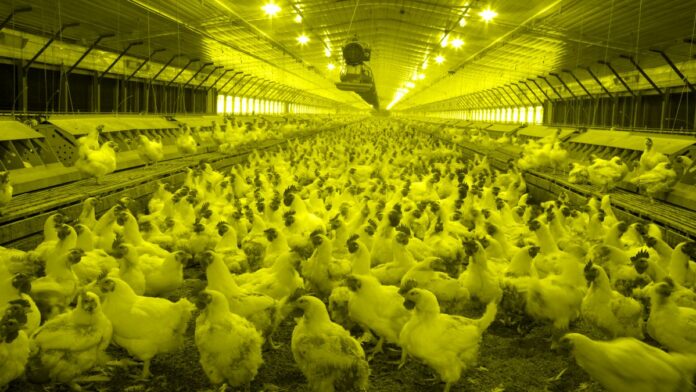Factory farming is the principal method of producing animal meat and other products for hamburgers, cheese, and eggs. However, it is far from a flawless process. Factory farming negatively impacts rural communities, the environment, and farm animals. As a result, advocates from all walks of life are pushing to shift away from these harmful industrial practices to create a more equitable and equitable food system.
Learn how it’s contaminating the air and water, generating massive amounts of greenhouse emissions that cause global warming, or endangering wild animals; there’s plenty of data to show why factory farming should be shut out.
Contents
- 1 What is Factory Farming?
- 2 History of Factory Farming
- 3 Advantages of factory farming
- 4 Disadvantages of Factory Farming
- 4.1 Factory farms release a significant quantity of greenhouse gases into the atmosphere.
- 4.2 Animal welfare is not included in the financial calculation of factory agriculture.
- 4.3 Factory farm animals are restricted in their movements.
- 4.4 Chickens and cattle grow to unnaturally large sizes.
- 4.5 Factory farm mesh flooring might be harmful to the animals’ feet
- 4.6 Factory farms may be subject to genetic modification
- 5 Effects of Factory Farming
- 6 Conclusion
- 7 Sources
What is Factory Farming?
Factory farms, also known as concentrated animal feeding operations (CAFOs), are a contemporary industrial method of raising farmed animals, commonly referred to as livestock. Factory farming is intensive agriculture that aims to optimize profits while using minimal resources. Large numbers of animals on factory farms are confined in cramped spaces, which usually means that the animals are kept indoors for the rest of their lives. Factory farming, which focuses on species such as cows, pigs, chickens, and fish, is becoming more popular for raising animals for food. However, CAFOs can also feed animals for purposes other than food, such as large-scale farming for their fur, leather, etc.
History of Factory Farming
Christopher Columbus and other European colonists landed in the Americas in 1492, bringing eight pigs, 25 horses, and many other animals. As a result, Colonial America gradually became economically dependent on livestock-based farming in the 16th century, in contrast to indigenous people’s traditional affinity for food and little focus on domesticated animals for nutrition. Thus the Industrial Revolution all over the world saw the large-scale production of animal agriculture from the 18th to the 19th century. It produces particular animal breeds, such as sheep with very long wool and huge calves like cows.
The discovery of antibiotics in the late 1930s and their ability to substantially reduce disease transmission in farmed animals rapidly led to higher yields in factory farming. Thus the average size of US farms doubled by the 1990s, leaving fewer animals on many local farms. After that, the industry declined from employing 47% of the US population to just 2%.
The swine flu (H1N1) pandemic in 2009 resulted in hundreds of thousands of animals and people dying. The virus was discovered about a decade ago in US industrial farms, then spread to pig farms and eventually spread to people.
Rural communities, workers, environmentalists, public health professionals, and the general public continue to mobilize against industrial farming. Models are still being promoted for a community-centered, plant-based food system and an end to all animal agriculture.
Advantages of factory farming
Food remains affordable due to the intensive procedures used in industrial farming.
In today’s world, American households spend less of their discretionary cash on food than in any other country. Even after considering the cost of eating out, the average family of four spends about 10% of their wages on food. This is four times less than the cost of food before the turn of the century and is equal to what people in other countries pay. Because of this unique benefit of industrial farming, you can feed the average family of four in the United States for about $6,000 per year.
It reduces food waste concerns thanks to industrial farms.
Factory farming currently produces more food than we need. According to Oxfam, agricultural production provides 20 percent more calories than humans need for a decent lifestyle. Every year, we waste more than 1.3 billion pounds of food, much of it at the distribution or retail level. Because factory farms use intensive farming practices, these products can be reintroduced into the food chain. The organic goods left behind can be used as fertilizers, animal nutritional supplements, and many other items that help maintain the entire economic food chain. In addition, due to the intensive approach, they offer processing enhancements that can extend the life of agricultural commodities by up to a week compared to a standard product.
It creates jobs that pay far more than the minimum wage.
Although the global median income for agricultural workers is less than $2 per day, it is much higher due to the extensive efforts made by factory farming in the United States. Ordinary workers in this profession earn about $12 an hour, which is about $5 more than the federal minimum wage. It also pays more than the minimum wage in most other states. According to the Bureau of Labor Statistics, if you can work in a managerial position on a farm, your hourly income will increase to about $18.
Foods reach the market faster as a result of factory farming.
Because of the global impact of factory farming on agricultural businesses, it takes very little time for livestock and poultry to be ready for consumption. For example, it takes about half the time for a chicken to be prepared for processing without affecting its weight profile. Due to the rapid processes in this field, cattle are now about 300 pounds heavier in their final weight. As a result, farmers can earn more; buyers pay less, and the amount of food available increases.
Intensive techniques allow employees to use equipment that automates laborious tasks instead of spending several minutes manually milking a cow. When an investment is significant enough, only a few people are needed to manage a whole herd, rather than what farmers need first. This benefit allows us to compensate people more for their jobs, expand the scaling options of the farm, and increase access to food simultaneously. Even if the family farm decides not to update, some automation improvements can reduce the number of early morning milkings throughout the year.
Disadvantages of Factory Farming
Factory farms release a significant quantity of greenhouse gases into the atmosphere.
Agricultural operations account for about 13% of greenhouse gas emissions worldwide each year. Since most farms do not account for this loss in their production levels, the expense can be very high. We know that the industry produces about 6 billion tons of harmful gases. Methane and nitrous oxide are significant contributors to this potential climate change trigger. Beef burping, natural fertilizers, and synthetic fertilizers account for 65 percent of agriculture-related emissions. Intensive farming practices lead to high emissions, which can lead to the development of pneumonia in animals.
Animal welfare is not included in the financial calculation of factory agriculture.
In industrial farming, there may be a need to reduce the number of animals. This problem becomes a problem when cattle fall ill. It is often more beneficial to kill and restart than to invest resources in recovery. About four out of every five pigs and pigs in the region have significant health problems that may never be treated because of the high cost. Pneumonia is a disease that affects all animals.
Factory farm animals are restricted in their movements.
Intensive farming methods attempt to produce more food in less space than traditional family-based farming methods. Even though this loss is not as common in the region as before, animals are often confined to an indoor setting without consideration of ethical issues. For example, chickens are sometimes held in larger cages than an iPad. Even if they can move freely, the tips of their wings or parts of their legs are cut off to limit their running away. This problem can affect the quality of the food, eventually making it to the processor.
Chickens and cattle grow to unnaturally large sizes.
Intensive farming practices place more emphasis on the end product rather than the means needed to get there. Consequently, these features are not uncommon to cross diverse species to obtain more efficient growth characteristics. Artificial stimulants are still used in some places to help animals gain weight. Therefore, the period from birth to processing can be halved or even more with some traditional farming goods. In less than 50 years of industrial farming, less food is needed each day, from three pounds to about 1.5 pounds, to achieve the same results by weight.
Factory farm mesh flooring might be harmful to the animals’ feet
Intensive farming practices have to deal with a lot of animal waste regularly. Laying poultry and cattle on a mesh floor allows feces and urine to pass through. This loss is one of the reasons why today’s animal proteins have a higher fat content than they used to. move it forward
Factory farms may be subject to genetic modification
Genetic engineering is popular on factory farms because it allows them to produce more items for the food chain while maintaining a lower cost profile. That is, the purpose of this loss is to make animals more valuable to us. However, selective breeding has faced challenges with milk supply, weight in chicken breasts, and other animal welfare concerns. Peter Stevenson, Chief Policy Advisor for Compassion at World Farming, says, “Gene editing to make animals produce more milk or grow faster is likely to cause even more pain and illness in our overworked farm animals.”
Effects of Factory Farming
Water Pollution
With large numbers of animals in confined spaces, their excrement has to be washed frequently or daily with water. That water comes into contact with fresh water or groundwater, surface water such as streams and rivers, and finally, the ocean. Or reach the beach.
Dead zones are places in the ocean where the spread of chemicals (such as nitrates in animal waste) causes algae blooms that deplete the oxygen in the water and destroy marine life. Factory farm runoff is one of the most common sources of water pollution in many countries worldwide.
Factory Farming uses a tremendous amount of water.
Freshwater is becoming a valuable resource, but factory farms consume much of it to feed their animals. Since there is a constant struggle against fecal build-up in highly packed conditions on a factory farm, a single dairy cow requires 40–50 gallons of water per day for drinking and cleaning.
Air Pollution
Air pollution is caused by the closure of large numbers of animals in small outdoor and indoor spaces. Many people are unaware that in poultry farms, where birds are raised for meat or eggs, birds spend most of their lives indoors, which is one of the most polluting causes of air pollution, because of the deadly gas ammonia is released from the bird’s litter, which contains a large amount of excrement, which is left to ferment. Air pollution harms not only animals but also employees and the general public.
Global Warming
Greenhouse gases such as methane, nitrous oxide, and carbon dioxide contribute to global warming. Animal agriculture accounts for about 14.5 percent of greenhouse gas emissions worldwide, mainly from cattle in the beef and dairy industries.
Deforestation
There is a reason why you don’t often see cattle grazing in the woods. Cattle grow fastest on extensive pastures with lots of grass. Thus farmers who want their calves to gain weight rapidly so they can be slaughtered as quickly as possible prefer these conditions. Unfortunately, while grasslands are found naturally in many parts of the world, forests are increasingly being burned to create new pastures for ever-increasing herds of cattle – all but consumer demand for steaks, hamburgers, and other meat products, in the name of completion.
Forests are destroyed not only to make room for pasture but also to make way for the crops needed to feed the billions of animals imprisoned in factory farms. Feedlots and dairy barns, chickens, turkeys, and cattle are fed crops such as soy, corn, and other grains.
This combined attack is particularly damaging to the Amazon rainforest, which lies mainly within Brazil’s borders. Unsurprisingly, animal farming is one of the significant causes of deforestation in this critical environment and worldwide.
Wildlife and Biodiversity
Wildlife and the biologically diverse world are threatened by vast tracts of land needed for meat production, pollution, and other impacts ravaging ecosystems. Land-use conversions for meat production were identified as a significant driver of biodiversity loss in a study published in 2021. Lambs and cattle bred for cattle have the most needs of any protein consumed by humans, and as a result of increased demand for meat around the world, wildlife habitats are being encroached upon at an unprecedented rate. Habitat destruction is a death sentence for the animals living there, many of which are already under threat.
Oceans and Fisheries
Factory farming has many effects on the oceans. Agricultural runoff pollutes the marine environment from two sources: runoff from crops used to feed factory-farmed animals containing excessive pesticides and synthetic fertilizers and animal waste from factory farms. Such runoff can result in algal blooms and dead zones, disrupting the ecosystem.
Factory farms are also submerged in water. Fish factory farms are concentrated animal feeding operations for species such as salmon. They are a type of aquaculture that also includes cultivated shellfish and seaweed. Fish waste and the liberal use of antibiotics, necessary to keep fish alive in these unnatural settings, pollute the waters in these open water cages, which are often located in the ocean’s relatively pristine and biodiverse sections. There are. Despite their best efforts, factory-farmed fish are commonly infected with unpleasant and often fatal diseases such as parasitic lice, which can later infect nearby wild fish populations. Each year, an estimated 50,000 wild salmon die from lice infestations in Norway.
Conclusion
In short, industrial farming is not the best method for meat production. Factory farming is a cruel practice, as well as skinning them while alive. Not only have they been abused this way, but some employees believe they have a right to kill animals before they die, which is technically animal abuse. We believe that humans need meat to survive, but there are better, less harmful alternatives, such as free-range farming, which will also reduce water usage. If this practice continues, soon farm animals will become extinct. There’s no set timetable, but pillaging the animals won’t make them live forever. Again, we have better alternatives, such as free-range farming, which provides more pleasant habitats for animals, which is a natural process and also more environmentally friendly.
Sources
- (2020, December 01). FACTORY FARMING: WHAT IT IS AND WHY IT’S A PROBLEM. THL.
- Farm Sanctuary, Inc. (n.d.). What is Factory Farming? Farm Sanctuary. Retrieved March 23, 2022, from https://www.farmsanctuary.org/issue/factory-farming/
- F. (2019, July 23). 21 Advantages and Disadvantages of Factory Farming. FutureofWorking.Com. Retrieved March 23, 2022, from https://futureofworking.com/10-advantages-and-disadvantages-of-factory-farming/
- R. (2020, August 17). Factory Farming: History, Effects, and Sustainable Solutions. Conserve Energy Future. Retrieved March 23, 2022, from https://www.conserve-energy-future.com/factory-farming.php
FACT CHECK: We strive for accuracy and fairness. But if you see something that doesn’t look right, please Contact us.
DISCLOSURE: This Article may contain affiliate links and Sponsored ads, to know more please read our Privacy Policy.
Stay Updated: Follow our WhatsApp Channel and Telegram Channel.












